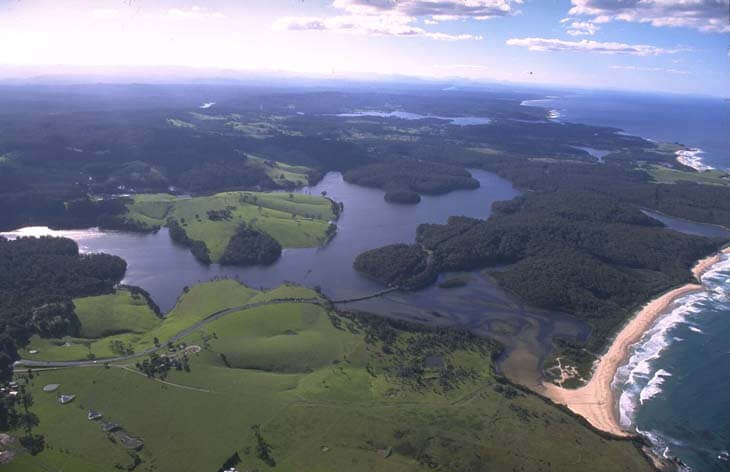Corunna Lake is a small lagoon on the south coast of New South Wales. It has an intermittently open entrance and the entrance flows into the ocean after heavy rainfall.
Water quality report card
As part of our water quality monitoring program we assess the water quality and ecosystem health of an estuary using a range of relevant indicators. We sample a subset of the estuaries between Wollongong and the Victorian border every 3 years. The most recent sampling in Corunna Lake was completed over the 2020–21 summer, when 2 sites were sampled on a monthly basis.
This report card represents 2 water quality indicators that we routinely measure: the amount of algae present and water clarity. Low levels of these 2 indicators equate with good water quality.
Algae
Water clarity
Overall grade
The report card shows the condition of the estuary was good with:
- algae abundance graded poor (D)
- water clarity graded excellent (A)
- overall estuary health graded fair (C).
Grades for algae, water clarity and overall are represented as:
- A – excellent
- B – good
- C – fair
- D – poor
- E – very poor.
Go to estuary report cards to find out what each grade means, read our sampling, data analysis and reporting protocols, and find out how we calculate these grades.
We have monitored water quality in the Corunna Lake since 2007. This table shows the water quality grades for this estuary over that time.
| Year | Algae | Water clarity | Overall grade |
|---|---|---|---|
| 2007–08 | C | B | C |
| 2017–18 | C | A | B |
Physical characteristics
| Estuary type | Lagoon |
|---|---|
| Latitude | –36.29 (ºS) |
| Longitude | 150.13 (ºE) |
| Catchment area | 29.7 km2 |
| Estuary area | 2.1 km2 |
| Estuary volume | 2299.6 ML |
| Average depth | 1.1 m |
Notes: km2 = square kilometres; m = metres; ML = megalitres.
Water depth and survey data
Bathymetric and coastal topography data for this estuary are available in our data portal.
Land use
The catchment of Corunna Lake is moderately disturbed due to almost half the catchment being cleared for urban or grazing land use at the townships of Corunna and Central Tilba. About half of the catchment is forested, some of which is managed by Forestry Corporation.
National and marine parks
- Eurobodalla National Park is the largest conservation area in this catchment and Corunna State Forest adjoins the lake.
- This estuary flows into Batemans Marine Park.
Citizen science projects
- iNaturalist’s Plants of Eurobodalla is a citizen science project that monitors plants found in the Eurobodalla region.
Community involvement
- Eurobodalla Landcare is a volunteer network of 24 Landcare groups on the NSW south coast.
- The Coastwatchers Association is a community environmental and conservation group based on the south coast.

Aerial view of Corunna Lake
Local government management
Local councils manage estuaries within their area unless the estuary is attached to a marine park.
Eurobodalla Shire Council manages this estuary, which is located in Batemans Marine Park.
Threatened species
Corunna Lake and the surrounding catchment area support a number of sea birds. One of these is the white-bellied sea eagle.
Find out about more about the biodiversity in our estuaries.